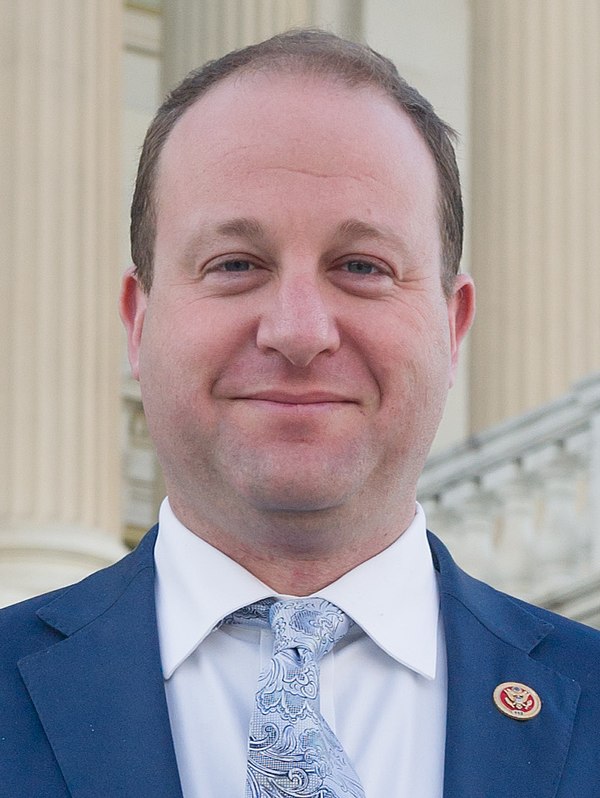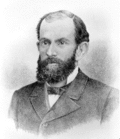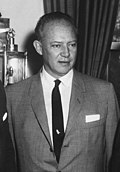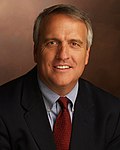Governor of Colorado
Chief executive of the U.S. state of Colorado From Wikipedia, the free encyclopedia
The governor of Colorado is the head of government of the U.S. state of Colorado. The governor is the head of the executive branch of Colorado's state government and is charged with enforcing state laws. The governor has the power to either approve or veto bills passed by the Colorado General Assembly, to convene the legislature, and to grant pardons, except in cases of treason or impeachment.[2] The governor is also the commander-in-chief of the state's military forces.
| Governor of Colorado | |
|---|---|
 Seal of the Executive Office | |
| Government of Colorado | |
| Style | The Honorable |
| Residence | Colorado Governor's Mansion |
| Term length | Four years, renewable once consecutively |
| Inaugural holder | John Long Routt |
| Formation | August 1, 1876 |
| Succession | Line of succession |
| Deputy | Lieutenant Governor of Colorado |
| Salary | $123,193 (2019)[1] |
| Website | www |
Seven people served as governor of Colorado Territory over eight terms, appointed by the president of the United States. Since statehood, there have been 38 governors, serving 43 distinct terms. One governor Alva Adams served three non-consecutive terms, while John Long Routt, James Hamilton Peabody, and Edwin C. Johnson each served during two non-consecutive periods. The longest-serving governors were Richard "Dick" Lamm (1975–1987) and Roy Romer (1987–1999), who each served 12 years over three terms. The shortest term occurred on March 16 and 17, 1905, when the state had three governors in the span of 24 hours: Alva Adams won the election, but soon after he took office, the legislature declared his opponent, James Hamilton Peabody, governor, but on the condition that he immediately resign, so that his lieutenant governor, Jesse McDonald, could be governor. Thus, Peabody served less than a day as governor.
The current governor is Democrat Jared Polis, who took office on January 8, 2019.
List of governors
Summarize
Perspective
Territory of Jefferson
The self-proclaimed Provisional Government of the Territory of Jefferson was organized on November 7, 1859.[3] Jefferson Territory included all of present-day Colorado, but extended about 3 miles (5 km) farther east, 138 miles (222 km) farther north, and about 50 miles (80 km) farther west.[4] The territory was never recognized by the federal government in the tumultuous days before the American Civil War. The Jefferson Territory had only one governor, Robert Williamson Steele, a pro-union Democrat elected by popular vote. He proclaimed the territory dissolved on June 6, 1861, several months after the official formation of the Colorado Territory, but only days after the arrival of its first governor.[5]
Territory of Colorado
The Territory of Colorado was organized on February 28, 1861, from parts of the territories of New Mexico, Utah, and Nebraska, and the unorganized territory that was previously the western portion of Kansas Territory.[6]
| No. | Governor | Term in office[a] | Appointed by | |
|---|---|---|---|---|
| 1 |  |
William Gilpin (1813–1894) [7][8] |
March 25, 1861[b] – March 26, 1862 (successor appointed)[c] |
Abraham Lincoln |
| 2 |  |
John Evans (1814–1897) [12][13] |
March 26, 1862[d] – October 17, 1865 (resigned)[e] |
Abraham Lincoln |
| 3 |  |
Alexander Cummings (1810–1879) [17][18] |
October 17, 1865[f] – May 8, 1867 (resigned)[g] |
Andrew Johnson |
| 4 |  |
Alexander Cameron Hunt (1825–1894) [26][27] |
May 8, 1867[h] – April 19, 1869 (successor appointed) |
Andrew Johnson |
| 5 |  |
Edward M. McCook (1833–1909) [30][31] |
April 19, 1869[i] – April 17, 1873 (successor appointed)[j] |
Ulysses S. Grant |
| 6 |  |
Samuel Hitt Elbert (1833–1899) [35][36] |
April 17, 1873[k] – July 26, 1874[l] (successor appointed) |
Ulysses S. Grant |
| 7 |  |
Edward M. McCook (1833–1909) [30][31] |
June 19, 1874[m] – February 8, 1875 (successor appointed)[n] |
Ulysses S. Grant |
| 8 |  |
John Long Routt (1826–1907) [45][46] |
February 8, 1875[o] – November 3, 1876 (elected state governor) |
Ulysses S. Grant |
State of Colorado
The State of Colorado was admitted to the Union on August 1, 1876.
To serve as governor, one must be at least 30 years old, be a citizen of the United States, and have been a resident of the state for at least two years prior to election. The state constitution of 1876 originally called for election of the governor every two years, with their term beginning on the second Tuesday of the January following the election.[49] An amendment passed in 1956, taking effect in 1959, increased terms to four years.[50] Originally, there was no term limit applied to the governor; a 1990 amendment allowed governors to succeed themselves only once.[51] There is however no limit on the total number of terms one may serve as long as one who has served the two term limit is out of office for four years.
Should the office of governor become vacant, the lieutenant governor becomes governor.[52] If both the offices governor and lieutenant governor are vacant, the line of succession moves down through the senior members of the state senate and state house of representatives of the same party as the governor.[53] The lieutenant governor was elected separately from the governor until a 1968 amendment to the constitution[54] made it so that they are elected on the same ticket.[55]
See also
Notes
- Gilpin was removed from office for improper financial drafts from the federal treasury.[8]
- Evans resigned at the request of President Johnson following the Sand Creek Massacre. The resignation was requested on July 18, 1865.[12]
- It is ambiguous exactly when Evans resigned and Cummings was appointed. Secretary of State William Seward requested Evans' resignation on July 18, 1865,[12] and Evans submitted it on September 4.[19] Modern sources say Cummings was appointed on October 17,[18] during a Senate recess, and sworn in to office on October 21;[17] however, contemporary news reported on his appointment as early as August 18,[20] and other major sources say he was appointed on August 8.[21] He was formally nominated on December 19,[22] and confirmed by the Senate on January 26, 1866.[23]
- Cummings resigned after being accused of misappropriating funds; despite being cleared of wrongdoing, his political career in the territory had been ruined.[24] Sources vary on when he resigned; modern sources almost all say April 1867,[17] but the best contemporary sources found say he tendered his resignation on May 8, the same day his successor was appointed.[25]
- Sobel notes that Pitkin ran unsuccessfully for Republican nomination for the United States Senate in 1882,[60] but no further details have yet been found as to which of the two Senate races that year he was running in.
- Represented the Republican Party
- Kallenbach labels Waite as a Populist and Silver Democrat.[85]
- Thomas was a Democrat,[59] but he has been described as a fusion candidate, as he also had support from the People's Party.[91][93]
- Represented the Populist Party
- Orman was a Democrat,[59] and was also nominated by the People's Party.[95]
- The 1904 election was rife with fraud and controversy. Alva Adams won election, but soon after he took office the Republican legislature declared James Peabody to be the actual winner, on the condition that Peabody immediately tender his resignation, postdated to the next day. Peabody's lieutenant governor, Jesse McDonald, then succeeded to the governorship.[105][106]
- Represented the Democratic Party
- Shafroth was instead elected to the United States Senate.[119]
- Johnson resigned, having been elected to the United States Senate.[152]
- Knous resigned, having been confirmed to the United States District Court for the District of Colorado.[172]
- First term under a 1956 constitutional amendment, which lengthened terms to four years.[50]
- Love resigned, having been appointed Director of the Office of Energy Policy.[189]
- Under a 1990 amendment to the constitution, governors may not serve more than two consecutive terms.[201]
- Polis' second term began on January 10, 2023,[211] and will expire on January 12, 2027; he will be term-limited.
References
External links
Wikiwand - on
Seamless Wikipedia browsing. On steroids.






































